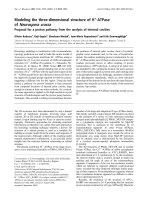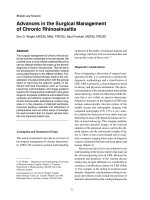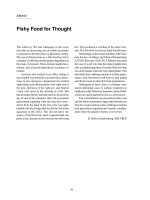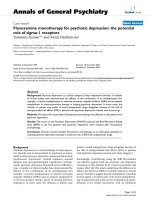Báo cáo y học: " Unique challenges for appropriate management of a 16-year-old girl with superior mesenteric artery syndrome as a result of anorexia nervosa: a case report" pptx
Bạn đang xem bản rút gọn của tài liệu. Xem và tải ngay bản đầy đủ của tài liệu tại đây (244.57 KB, 5 trang )
BioMed Central
Page 1 of 5
(page number not for citation purposes)
Journal of Medical Case Reports
Open Access
Case report
Unique challenges for appropriate management of a 16-year-old girl
with superior mesenteric artery syndrome as a result of anorexia
nervosa: a case report
Philip A Verhoef*
1,2
and Angelika Rampal
2
Address:
1
Department of Internal Medicine, University of California, Los Angeles, Le Conte Ave, Los Angeles, CA, USA and
2
Department of
Pediatrics, Mattel Children's Hospital at the University of California, Los Angeles, Le Conte Ave, Los Angeles, CA, USA
Email: Philip A Verhoef* - ; Angelika Rampal -
* Corresponding author
Abstract
Introduction: Nausea and vomiting in an adolescent, though common presenting symptoms,
often pose a diagnostic and therapeutic challenge to the physician. When the diagnosis involves
both medical and psychiatric components, management can be complex, especially in the current
healthcare system in the United States. To the best of our knowledge, there have been no previous
publications detailing successful management of a patient with anorexia nervosa and superior
mesenteric artery syndrome.
Case presentation: We report the case of a 16-year-old Caucasian girl who presented to our
emergency department with nausea, abdominal pain, diminished appetite and vomiting. Her history
and examination were notable for a 15 kg weight loss and diffuse abdominal tenderness. A barium
swallow X-ray with small bowel follow-through and computed tomography scan demonstrated
remarkable duodenal narrowing between the superior mesenteric artery and the aorta, consistent
with superior mesenteric artery syndrome. Initial management focused on relieving the obstruction
and supporting the nutritional needs of the patient. Further history confirmed a diagnosis of
anorexia nervosa, requiring intensive psychiatric and medical management, and necessitating a
multifaceted approach to patient care involving social work, multiple primary care physicians and
subspecialists, insurance company representatives, and the patient's immediate family.
Conclusion: This case illustrates important points regarding the pathogenesis of superior
mesenteric artery syndrome in the setting of anorexia, and it highlights the complexities that arise
when managing an adolescent with both medical and psychiatric needs, as well as outlining a viable
solution. While superior mesenteric artery syndrome is an uncommon cause of small bowel
obstruction, the general pediatrician and child psychiatrist should be aware of this complication of
anorexia nervosa.
Introduction
In this case report, we describe an adolescent girl who pre-
sented to the emergency department with the common
symptoms of nausea, vomiting, and abdominal pain, but
who was found to have a small bowel obstruction and
anorexia nervosa. The small bowel obstruction occurred
Published: 16 November 2009
Journal of Medical Case Reports 2009, 3:127 doi:10.1186/1752-1947-3-127
Received: 6 February 2008
Accepted: 16 November 2009
This article is available from: />© 2009 Verhoef and Rampal; licensee BioMed Central Ltd.
This is an Open Access article distributed under the terms of the Creative Commons Attribution License ( />),
which permits unrestricted use, distribution, and reproduction in any medium, provided the original work is properly cited.
Journal of Medical Case Reports 2009, 3:127 />Page 2 of 5
(page number not for citation purposes)
as a result of weight loss secondary to the anorexia, which
then led to loss of the omental fat pad and consequent
compression of the duodenum between the superior
mesenteric artery (SMA) and the aorta. While this particu-
lar association has been described previously, appropriate
management, especially in the setting of the current US
healthcare system, has not. Specifically, the adolescent
had two distinct diagnoses - each was potentially life-
threatening, yet appropriate management for one diagno-
sis seemed mutually exclusive of appropriate manage-
ment for the other. We therefore describe various
treatment options for managing both anorexia and SMA
syndrome, and illustrate how we utilized a variety of
resources to develop a novel and appropriate care strategy
for this patient.
SMA syndrome was first described in a case report in
1842, and has since been described under various other
names, including Wilkie disease, duodenal arterial
mesenteric compression, duodenal ileus, and megaduo-
denum [1-3]. SMA syndrome is generally felt to result
from compression of the duodenum between the superior
mesenteric artery anteriorly/dorsally and the aorta (and
behind the aorta, the vertebral column) posteriorly/ven-
trally [4]. This compression results from the loss of fatty
tissue, which surrounds the superior mesenteric artery
and its neurovascular pedicle. This can be a result of either
weight loss or a rapid growth spurt. In the absence of an
appropriate fatty scaffolding, the angle at which the SMA
branches from the aorta is reduced resulting in compres-
sion of the third portion of the duodenum between the
SMA and the aorta [4].
In our patient, SMA syndrome resulted from weight loss
associated with anorexia nervosa. The Diagnostic and Sta-
tistical Manual of Mental Disorders, 4th Edition (DSM IV)
diagnosis of anorexia nervosa is based on a patient meet-
ing four criteria [5]: (1) the patient refuses to maintain a
normal body weight, thereby resulting in a body weight of
less than 85% of the ideal body weight; (2) patients have
an intense fear of gaining weight or becoming fat; (3) the
patient has a sense of body image dysmorphism; and (4)
presence of amenorrhea in women (the absence of at least
three consecutive menstrual cycles). Diagnosis, treatment
and complications have recently been reviewed, and given
that the standardized mortality ratio of patients with ano-
rexia nervosa compared with the general population is
11.6 for all causes of death and 56.9 for suicide, anorexia
nervosa remains a very important disorder to recognize
and treat [5].
Though the incidence of SMA syndrome is thought to be
quite low, the risk to the patient of complete obstruction
forces the clinician to have a high index of suspicion in
those patients who present with bilious vomiting and
weight loss. Patients may have a history of early satiety
related to delayed gastric emptying. However, a complete
differential, including malrotation with volvulus, obstruc-
tion secondary to adhesions or masses, pancreatitis, pep-
tic ulcer disease and motility disorders must be
considered. Useful imaging includes a plain film of the
abdomen that may reveal a 'double bubble' indicating
duodenal obstruction, an upper gastrointestinal (GI)
study that shows failure of contrast to flow distal to the
third portion of the duodenum, and a computed tomog-
raphy (CT) or magnetic resonance imaging/arteriography
(MRI/MRA) scan with contrast demonstrating duodenal
compression between the SMA and aorta [4].
Management begins with immediate attention to the
small bowel obstruction, namely decompression via
nasogastric (NG) tube placement and surgical consulta-
tion. After stabilization, management of SMA syndrome
ranges from conservative attempts to increase weight with
enteral tube feedings or parenteral nutrition, to more
aggressive surgical therapy. Given that the gut is fully func-
tioning distal to the site of obstruction, enteral tube feed-
ings are preferred to parenteral nutrition, which has
multiple side effects, including cholestasis. Surgical ther-
apy may involve duodenojejunoanastomosis or gastroje-
junoanastomosis aimed at bypassing the area of
obstruction. Alternative surgical management may be
removal of the ligament of Treitz in order to relieve the
obstruction and allow greater intestinal mobility. Surgical
management is necessary if medical management does
not relieve the obstruction, if a nasojejunal (NJ) tube can-
not be passed distal to the compression, or if the compres-
sion is not relieved by repletion of fat stores [1,2].
Medical management usually consists of tube feeds. A NJ
tube can be progressed across the site of obstruction to
provide enteral feeds. Feeds should be started at a low rate
and advanced slowly in order to prevent refeeding syn-
drome, seen in individuals who quickly transition from a
state of malnourishment to feeding. Electrolytes should
be monitored closely, especially for hypophosphatemia,
which can cause cardiac failure [2].
Weight gain must initially be followed daily, and then
monitored at regular intervals by the pediatrician and spe-
cialists involved. The goal is to replete fat stores to decom-
press the third portion of the duodenum and eventually
transition to oral feeds. Once on a stable regimen, the
tube feeds can be given at home. The patient can ulti-
mately be challenged with small amounts of ice chips and
then liquids once he/she has begun regaining weight. Oral
food intake can be advanced while simultaneously treat-
ing the underlying cause for the patient's SMA syndrome.
All management should take place in consultation with
GI, surgery, and adolescent specialists [2].
Journal of Medical Case Reports 2009, 3:127 />Page 3 of 5
(page number not for citation purposes)
Case presentation
We report the case of a 16-year-old Caucasian girl who
presented to the emergency department complaining of
severe nausea, epigastric pain, decreased appetite and
vomiting.
Two weeks before admission, she experienced an acute
onset of nausea, non-bilious vomiting, and diarrhea,
which resolved within 24 hours. During the week before
admission, she had an intermittent, dull, diffuse abdomi-
nal pain and decreased appetite. Over the few days before
presentation, she had non-bilious emesis that progressed
to bilious emesis. Her pain was non-radiating, sharp in
nature and localized to the epigastric area. The pain was
relieved with vomiting but it worsened after attempting to
take in solids or liquids. She denied fevers, upper respira-
tory infection symptoms, hematemesis, hematochezia, or
melena.
Further questioning revealed that during the 16 months
before presentation, she had lost 22 kg (49 pounds).
Upon questioning of both the patient and her mother, it
was discovered that she had deliberately eliminated fat
and meat from her diet and increased the amount of exer-
cise she engaged in, including playing soccer and running.
She described her body as 'sub-par' and she felt that she
was challenging herself to be 'better'. She called herself a
'perfectionist' and was easily stressed out by school. How-
ever, she denied having a fixation with body image,
although her mother privately reported that she had
shown preoccupation with dieting, nutrition, and exer-
cise. With her new diet and exercise regimen, she began to
lose weight and she stated that she enjoyed the compli-
ments she received regarding her physical appearance. She
reported taking in approximately 900 calories per day and
exercising more vigorously: she was running 3.5 miles
three times a week and engaged in yoga for 1.5 hours a day
on non-running days and was also playing soccer. As she
continued on her diet and exercise regimen, she eventu-
ally reached a weight of 40 kg, down from her baseline of
61 kg. At that time, she was confronted by family and
friends regarding her extreme thinness. She worked with
her mother and her pediatrician in an attempt to increase
her caloric intake and reduce her level of exercise. She
acknowledged, on hospital admission, that she never ate
more than 1800 calories a day, despite the agreements she
made with her pediatrician and mother. Of note, she
stopped having menses over a year before presentation.
Her physical examination on admission was notable for
bradycardia (pulse ranging from 45 to 55), with a weight
of 39 kg (z-score for age: -2.5), height of 161 cm (z-score
-0.5) and body mass index (BMI) of 15 (z-score -2.9). The
girl was cachectic and did not look well. Her head and
neck examination was normal, including normal denti-
tion. Her lungs were clear and she had normal respiratory
effort. Her abdominal examination revealed diffuse ten-
derness to palpation and hypoactive bowel sounds. There
were no masses or organomegaly. The rest of her examina-
tion was unremarkable.
Her evaluation in the emergency department included a
barium swallow X-ray with small bowel follow-through
that demonstrated an extremely dilated stomach and an
inability of contrast to flow past the third portion of the
duodenum (Figure 1). A CT scan also revealed a dilated
stomach and proximal duodenum in addition to severe
narrowing of the third portion of the duodenum. Axial
contrast-enhanced CT during the arterial phase clearly
demonstrated compression of the duodenum between the
superior mesenteric artery and the aorta (Figure 2). The
patient underwent immediate nasogastric tube decom-
pression, resulting in relief of her epigastric pain and
drainage of approximately 100 ml of bilious fluid. Labo-
ratory evaluation at admission included electrolytes that
were significant for a reduced chloride (95 mmol/l) and
an elevated bicarbonate (36 mmol/l), consistent with
emesis and a subsequent contraction alkalosis. Her amy-
lase was 141 U/l, and lipase was 164 U/l, and her com-
plete blood count and liver function studies were
essentially normal.
After immediate decompression of her small bowel
obstruction and consultation with pediatric surgery, an NJ
Barium swallow X-ray with small bowel follow-through dem-onstrating obstructed flow of contrast at the mid-third por-tion of the duodenumFigure 1
Barium swallow X-ray with small bowel follow-
through demonstrating obstructed flow of contrast
at the mid-third portion of the duodenum.
Journal of Medical Case Reports 2009, 3:127 />Page 4 of 5
(page number not for citation purposes)
tube was placed to provide nutrition beyond the site of
obstruction. The pediatric surgical service felt that surgery
would not be necessary if medical management could
replete the patient's neurovascular fat stores to relieve the
duodenal compression and prevent future compression.
She was started on a tube feed regimen that provided 1800
kcal/day (47 kcal/kg/day), and was gradually titrated up
to provide maximal caloric support, while monitoring for
refeeding syndrome. Her ideal weight, based on a BMI of
20, was 54 kg, and we felt that she should regain at least 3
kg before initiation of oral feeds. The child psychiatry
service diagnosed anorexia nervosa, restricting type, based
on her weight restriction for 16 months, her excessive
exercise, her low BMI, and her preoccupation with nutri-
tion and exercise. They recommended transfer to an in-
patient eating disorders unit, but her requirement for NJ
feeds precluded this transfer. They felt that she should
remain hospitalized until the NJ tube could be removed,
followed by transfer to the eating disorders unit, but the
patient and her family were not comfortable with this
plan. Ultimately, after many multidisciplinary meetings
involving nursing, discharge planners, insurance com-
pany representatives, the family, and the involved physi-
cians, an out-patient eating disorder therapist was
identified who agreed to provide regular counseling three
times per week. This allowed the patient to be discharged
home on tube feeds, while still receiving appropriate psy-
chotherapy for her anorexia.
Six weeks after hospital discharge, the patient was tolerat-
ing approximately 1600 kcal/day of NJ-tube feeds and
1300 kcal/day of a diet consisting of protein shakes,
yoghurt, and soft foods, without nausea, vomiting, or
constipation. She transitioned to a 3000 kcal/day oral diet
without difficulty and the NJ tube was discontinued
shortly thereafter. Once the NJ tube was removed, she
enrolled in an out-patient eating disorders day program,
where she continued to receive intensive daily therapy for
more than a month. She began having regular menstrual
cycles again, and was able to maintain her weight at an
appropriate level. One year after discharge from the hos-
pital, her weight was 53 kg, and she remains an avid ath-
lete and excellent student.
Discussion
SMA syndrome in the setting of anorexia nervosa has been
recognized, but there have been no published reports
indicating how SMA syndrome might be successfully
managed in the setting of anorexia [6]. There are two case
reports which describe individual patients with anorexia
nervosa and SMA syndrome who were unwilling to com-
ply with psychotherapy and consequently underwent
multiple endoscopies and gastrojejunostomy without
improvement in their respective conditions [7,8]. Clearly,
this combination of pathologies is uniquely challenging:
SMA syndrome can precipitate and exacerbate anorexia
nervosa because of the nausea associated with a small
bowel obstruction and conversely, anorexia nervosa pre-
vents the patient from being willing or able to ingest ade-
quate calories to allow the SMA syndrome to resolve.
In our case, the patient no longer needed to be hospital-
ized for medical treatment alone as tube feeds could be
given at home. Convincing the family and involved par-
ties, however, that hospitalization was required in order
to provide regular psychiatric follow-up for the potentially
fatal disease of anorexia, was difficult. Various options
were discussed: (1) that she remain hospitalized on the
pediatrics ward for tube feeds, with monitoring and
encouragement of caloric intake and weight gain, and
treatment by the psychiatry consult service; (2) that she be
transferred to the in-patient eating disorders unit while
continuing NJ-tube feeds; (3) that she be discharged
home, but monitored closely by her pediatrician, and that
she be admitted to a partial psychiatric program with ther-
apy from approximately 8.00 a.m. to 2.00 p.m.; (4) that
she have the NJ tube removed in an attempt to begin liq-
uid feeding and that she be immediately transferred to the
in-patient eating disorders program; (5) that she have sur-
gical correction, after which she could immediately
resume oral feeds, and in-patient psychiatric evaluation;
and (6) that she be discharged home with close follow-up
by her pediatrician and an out-patient therapist, and that
she be subsequently admitted to either the full in-patient
Computed tomography scan demonstrating compression of the duodenum between the patient's aorta (white arrow) and superior mesenteric artery (black arrow)Figure 2
Computed tomography scan demonstrating com-
pression of the duodenum between the patient's
aorta (white arrow) and superior mesenteric artery
(black arrow).
Publish with BioMed Central and every
scientist can read your work free of charge
"BioMed Central will be the most significant development for
disseminating the results of biomedical research in our lifetime."
Sir Paul Nurse, Cancer Research UK
Your research papers will be:
available free of charge to the entire biomedical community
peer reviewed and published immediately upon acceptance
cited in PubMed and archived on PubMed Central
yours — you keep the copyright
Submit your manuscript here:
/>BioMedcentral
Journal of Medical Case Reports 2009, 3:127 />Page 5 of 5
(page number not for citation purposes)
or the partial in-patient eating disorders program after her
weight had stabilized and the NJ tube could be removed.
We did not feel she should be subjected to the risks of sur-
gical intervention solely to expedite her admission to the
psychiatric unit if other non-surgical options existed. We
were also concerned about the psychological and finan-
cial consequences to the patient and her family of pro-
longed hospitalization in an acute-care facility. The
psychiatry service felt that they were ill-equipped to care
for a patient receiving NJ-tube feeds on either an in-
patient or out-patient service, and that the patient's NJ
tube could have an adverse impact on other participants
in group therapy sessions. Ultimately, an interdisciplinary
effort was required to create a plan that included appropri-
ate, high-level out-patient therapy for severe anorexia
along with continued medical management by both the
patient's pediatrician and gastroenterologist.
An ability to navigate the healthcare system via interdisci-
plinary management, including multiple subspecialists,
nursing, discharge planning and insurance companies is
now part and parcel of patient care. In this case, the mem-
bers of the interdisciplinary team benefited from an
actively involved discharge planner and insurance repre-
sentative. In those patients who have minimal or no
health insurance, psychiatric management becomes an
even more difficult challenge given that many in-patient
psychiatric units do not accept Medicaid insurances. As
physicians are trained to advocate for patients and pro-
vide them with excellent care, it is fundamental to realize
that the effectiveness of patient advocacy and patient care
is intensified by the ability of the physician to know,
understand, utilize and navigate the resources that are
available in the various healthcare systems where we serve
our patients.
Conclusion
Nausea and vomiting, while common presenting symp-
toms, may represent a life-threatening illness with both
medical and psychiatric etiologies. The clinician must be
adept at recognizing the evidence of small bowel obstruc-
tion as well as the presence of mental illness that contrib-
utes to both the development of medical disease and
complicates its treatment. This case report explores all of
these issues and outlines an approach to therapy, which is
multi-faceted and best serves the patient.
Abbreviations
CT: computed tomography; DSM IV: Diagnostic and Sta-
tistical Manual of Mental Disorders, 4th Edition; GI: gas-
trointestinal; MRI/MRA: magnetic resonance imaging/
arteriography; NG: nasogastric tube; NJ: nasojejunal tube;
SMA: superior mesenteric artery
Consent
Written informed consent was obtained from the patient
for publication of this case report and any accompanying
images. A copy of the written consent is available for
review by the Editor-in-Chief of this journal.
Competing interests
The authors declare that they have no competing interests.
Authors' contributions
PV worked under the supervision of AR in the care of this
patient. PV and AR worked jointly together to develop the
outline for this case report, review necessary data, generate
the figures, and draft the final written version of the man-
uscript.
Acknowledgements
The authors would like to thank Martin Anderson, MD for reviewing this
article. Preparation of this article did not require an outside funding source.
References
1. Adson DE, Mitchell JE, Trenkner SW: The superior mesenteric
artery syndrome and acute gastric dilatation in eating disor-
ders: a report of two cases and a review of the literature. Int
J Eat Disord 1997, 21:103-114.
2. Biank V, Werlin S: Superior mesenteric artery syndrome in
children: a 20-year experience. J Pediatr Gastroenterol Nutr 2006,
42:522-525.
3. Rokitansky K: Handbuch der pathologischen Anatomie Vienna: Brau-
muller and Siedel; 1842.
4. Valdes A, Cardenas O, Espinosa A, Villazon O, Valdes V: Superior
mesenteric artery syndrome. J Am Coll Surg 2005, 201:808.
5. Yager J, Andersen AE: Clinical practice. Anorexia nervosa. N
Engl J Med 2005, 353:1481-1488.
6. Jordaan GP, Muller A, Greeff M, Stein DJ: Eating disorder and
superior mesenteric artery syndrome. J Am Acad Child Adolesc
Psychiatry 2000, 39:1211.
7. Elbadaway MH: Chronic superior mesenteric artery syndrome
in anorexia nervosa. Br J Psychiatry 1992, 160:552-554.
8. Froese AP, Szmuilowicz J, Bailey JD: The superior-mesenteric-
artery syndrome: cause or complication of anorexia ner-
vosa? Can Psychiatr Assoc J 1978, 23:325-327.









